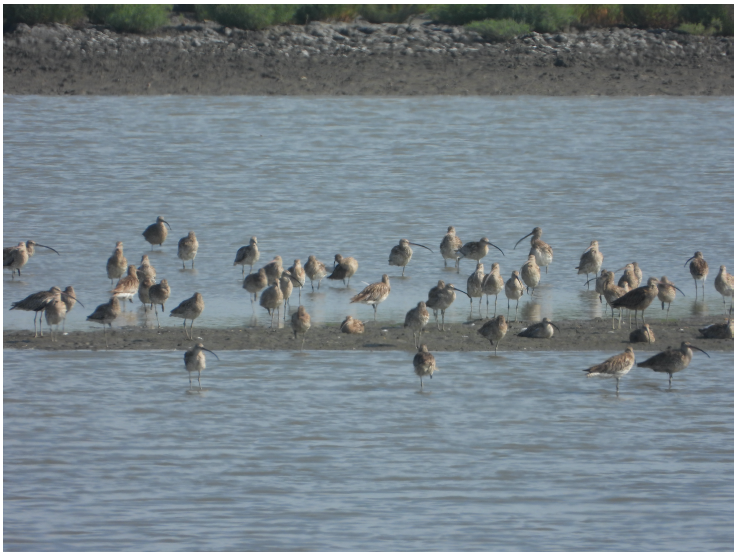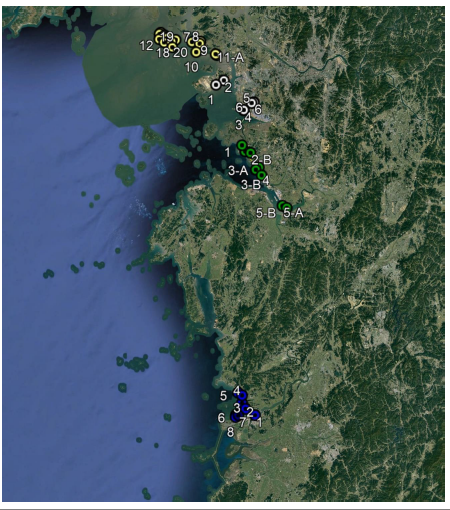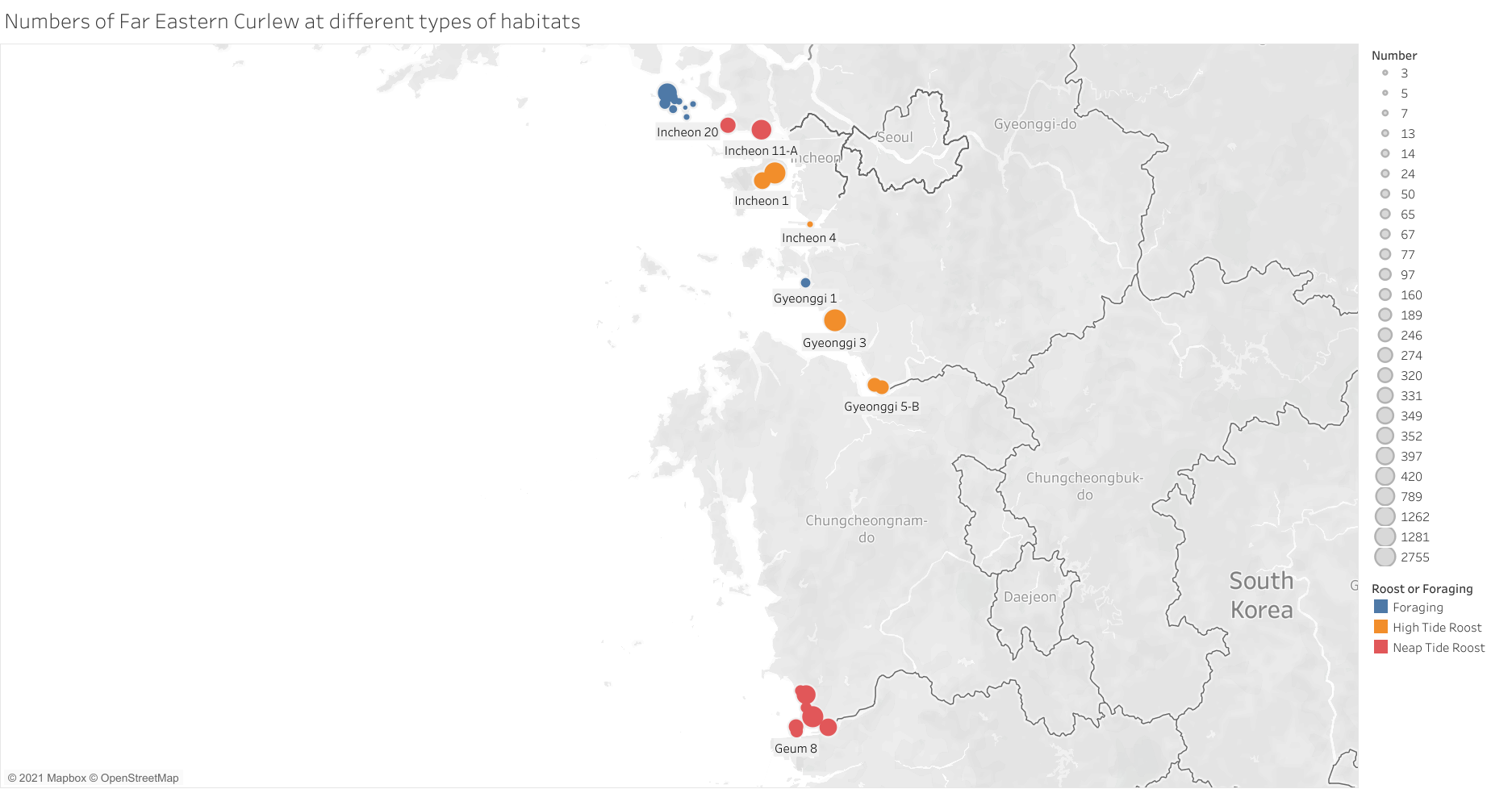
A flock of Far Eastern Curlew in Yeongjong Island, Incheon © Black-faced Spoonbill and Friends
Following the suggestion from the EAAFP Secretariat and Birds Korea in 2020 based on the ecological survey in the Hwaseong Wetlands Flyway Network Site (FNS) in 2020 and existing data from the National Institute of Biological Resources (NIBR), three local governments in ROK, Hwaseong City, Seocheon County, Yeonsu District of Incheon City, initiated the Far Eastern Curlew Network in the Korean Peninsula since 1st December 2020.
As a secretariat of the network, Hwaseong City supported the Far Eastern Curlew survey held in July 2021, following the advice of Birds Korea and the EAAFP Secretariat.
Dr. Nial Moores of Birds Korea, the principal researcher for the ecological survey at the Hwaseong Wetlands FNS since 2020, has found the peak count of Far Eastern Curlew visiting the FNS and adjacent areas was in late July. He set the hypothesis “The peak season of Far Eastern Curlews in ROK is in the late July” based on the survey data and reference studies in Australia and other wintering sites. He suggested the national survey in ROK is best to be placed in late July, and Hwaseong City took the suggestion as a project of the network.
Birds Korea and the EAAFP Secretariat encouraged other organizations to participate in the survey to cover the Gyeonggi Bay and the Geum Estuary. Led by Birds Korea, NGOs including Black-faced Spoonbill and Friends, Eco-Education Cooperative Eco-Education Cooperative Moo-Sae-Al as well as several participants from KFEM Gyeonggi, Chonnam National University and the EAAFP Secretariat, worked together to conduct the census
From July 21st to 25th 2021, 26 survey participants counted Far Eastern Curlews and other species at 34 sites in the three areas: parts of coastal Incheon (Ganghwa Island, Yeongjong Island and Songdo, the Han Estuary); the adjacent Gyeonggi Coast (the Hwaseong Wetlands and Asan Bay); and the Geum Estuary (Figure 1). Participants are experienced counters with specialist knowledge of their areas.
A total of 9,642 Far Eastern Curlews were recorded with 3,746 in Incheon; 3,255 in parts of Gyeonggi mainland coast; and 2,641 in Geum Estuary. This is around a third of the world’s population of the species, which was estimated to be 32,000 individuals (range: 20,000 – 49,000 individuals, source: https://www.iucnredlist.org/)

Figure 1 The three main count areas on the Yellow Sea coast of the ROK
The majority of Far Eastern Curlews were recorded in areas either protected or close to the borderline with DPRK where there is less development pressure. However, almost none of the roosting sites have any formal protection or any management plan; and ongoing reclamation and associated developments currently threaten roosting sites used by at least 2,500 Far Eastern Curlews.

Figure 2 The type of habitats and the numbers of Far Eastern Curlews indicates with the sizes of the circles; The result table on the report was reconstructed into a figure on Tableau.
Figure 2 The type of habitats and the numbers of Far Eastern Curlews indicates with the sizes of the circles;
The result table on the report was reconstructed into a figure on Tableau.
The survey helps to identify 11 areas of tidal flats and associated roosting sites in the ROK for the globally Endangered Far Eastern Curlew:
(1) tidal flats around Boreum Island (Incheon count sites 12-18);
(2) tidal flats around southern Ganghwa Island (Incheon count sites 8- 11);
(3) tidal flats and two discrete roosting sites in southern Yeongjong Island (Incheon counts sites 1 and 2);
(4) tidal flats and the artificial roosting site in Songdo (Incheon count sites 4 and 6);
(5) tidal flats in Maehwari, Hwaseong (Gyeonggi count site 2-B);
(6) the Hwaseong Reclamation Lake, as a roosting site (Gyeonggi count site 3);
(7) Maehyangri Tidal Flat, Hwaseong (Gyeonggi count site 4);
(8) Asan Bay, tidal flat and roosting sites within Asan Bay reclamation impoundments (Gyeonggi count sites 5);
(9) the Geum River channel tidal flats;
(10) the Seocheon County coast, between Songrimri and Jangguri (Geum count sites 2-4); and
(11) the tidal flats and saltpans around Yubu Island, Seocheon County (Geum counts sites 6-8).
The survey, therefore, helps to highlight the importance of tidal flats in the ROK to Far Eastern Curlew and confirms the need for more research in the ROK focused on Far Eastern Curlew.
Incheon
Several foraging sites of Far Eastern Curlews are not going to be developed soon because of their locations close to the inner border of Korea. At the same time, Haeju Bay in DPRK is suspected as a roosting area during high spring tide for the Far Eastern Curlews who forage in Boreum Island in ROK.
Some sites in Incheon have been more vulnerable to degradation and disturbance by people. A huge area of tidal flats where shorebirds forage on south coast of Yeonjong is surrounded by infrastructures; old saltpans are also vulnerable under development pressure related to the international airport.
In addition, survey participants report that Far Eastern Curlew and other shorebirds that forage on the Gojan Tidal Flat, part of the Songdo Ramsar Site at low tide, currently roost in an ongoing reclamation area (count site 4). Incheon City currently has plans to continue construction in this area for shorebirds’ roosts which will be reduced. The closest alternative roost area which birds forage on the Gojan Tidal Flat appears to be shallow reclamation ponds in Sihwa Reclamation Lake, approximately 14km away.
Gyeeongi Coast
Due to the reclamation along the coastal areas, the number of Far Eastern Curlews has decreased. During the surveys at the Hwaseong Wetlands FNS in 2020, Far Eastern Curlews use different roosting sites with different tide heights. Like the previous suggestion of other studies, Far Eastern Curlews don’t want to move more than 11 km as daily distance, the team found Far Eastern Curlew tried not to leave the tidal flat in Seokcheon-ri to the Hwaseong Lake, even though the tide height was 8.1~8.5 m.
Geum Estuary
Following the closure of the Saemangeum seawall in 2006, Geum Estuary became the most important known shorebird site in the ROK (Moores et al. 2008, 2016).
Much of the Seocheon County side of the Geum Estuary is now protected formally both as a Ramsar site and since mid-2021 also as the Seocheon Getbol World Heritage Property. However, the current boundaries of the World Heritage Property do not extend to include some of the shoreline used by roosting Far Eastern Curlew and the Geum River channel used by large numbers of foraging Far Eastern Curlew. These areas are instead included within the buffer zone.
2021년 7월 한국 알락꼬리마도요 조사(경기만, 금강하구)
화성습지 철새이동경로 네트워크 서식지(Flyway Network Site, FNS) 상에서 이뤄진 2020 생태조사 및 국립생물자원관 도요조사 결과 자료를 바탕으로, EAAFP 사무국과 새와생명의터에서는 2020년 중반 한국 내의 지방정부에 알락꼬리마도요 한반도 네트워크의 결성을 제안하였다. 경기도 화성시, 충청남도 서천군, 인천광역시 연수구는 2020년 12월 1일부로 알락꼬리마도 한반도 네트워크를 발족하였다. 알락꼬리마도요 한반도 네트워크의 사무국인 화성시는 새와생명의터와 EAAFP 사무국로부터 자문을 받아 2021년 7월 알락꼬리마도요 조사를 지원하였다.
2020년부터 추진한 화성습지 생태조사의 책임연구원인 나일 무어스 대표(새와생명의터)는 화성습지 및 인근지역에서 연간 가장 많은 알락꼬리마도요 개체수가 기록된 기간이 7월말이라는 사실에 주목하였고, 한국에 해당 새가 가장 많이 방문하는 기간도 같을 것이라고 가설을 세웠다. 또한 7월말에 전국 조사를 제안하였으며, 화성시에서는 이 제안을 받아 네트워크 사업으로 추진하였다.
새와생명의터와 EAAFP 사무국은 경기만과 금강하구 지역을 모두 조사할 수 있도록 다른 기관들의 참여를 독려하여저어새와친구들, 생태교육허브물새알 협동조합이 참여하였고, 그 외에 경기환경운동연합, EAAFP 사무국, 전남대학교 소속의 조사자들도 참여하였다.
2021년 7월 21~25일, 2해당 지역 조사의 경험이 많은 26 명 참가자들은 3개의 큰 지역에서 알락꼬리마도요 및 다른 종들을 계수하였다. 1) 인천광역시의 강화도, 영종도, 송도지역, 한강하구. 2)화성습지와 아산만을 포함한 경기도 해안. 3) 금강하구(그림 1).
그 결과, 총 9,642 마리의 알락꼬리마도요가 관측되었다. 인천지역에 3,746, 경기도 해안에 3,255, 금강하구에 2,641 개체이다. 이는, 전 세계 개체수 약 32,000의 1/3이상 이다. (범위 : 20,000 – 49,000 개체, 출처 : https://www.iucnredlist.org/)
알락꼬리마도요를 관측한 지점들은 대체로 현재 보호지역이거나 북한과 경계선과 가까워서 근시일 내 개발압이 있지는 않을 것이나휴식지들은 공식적인 보호가 되어 있거나 관리계획이 만들어져 있는 곳이 없다. 2,500 개체 이상 알락꼬리마도요들이 휴식하는 서식지는 매립과 관련 개발 등의 위협이 있다
본 조사는 알락꼬리마도요가 서식하는 지역(갯벌과 이웃한 만조 시 휴식지) 총 11개의 지역을 확인하였다.
(1) 볼음도 주변 갯벌 지역(인천 지점 12~19),
(2) 강화도 남쪽의 갯벌 지역(인천 지점 8~11),
(3) 영종도 남단의 갯벌과 만조 시 휴식지 두 곳(인천지점 1~2),
(4)송도 갯벌과 인공 번식지(인천 지점 4, 6),
(5) 화성시 매화리 갯벌(경기해안 지점2-B),
(6) 번식지인 화성간척호(경기해안 지점 3),
(7) 화성시 매향리 갯벌(경기해안 지점 4),
(8) 아산만 갯벌과 아산만 간척지 저류지 내 휴식(경기해안 지점 5),
(9) 금강수로 갯벌,
(10) 서천군 해안 송림리, 장구리 사이의 해안 (금강 지점 2-4),
(11) 유부도 주변의 염전과 갯벌(금강 지점 6-8).
결국 본 조사는 알락꼬리마도요에게 한국 갯벌이 얼마나 중요한지를 보여주며, 더 많은 알락꼬리마도요 연구조사가 필요함을 시사한다.
인천
알락꼬리마도요의 먹이터 일부는 한반도 내 국경에 위치하고 있으므로 당분간은 개발압이 없을 것이다.
북한의 해주만은 밀물 때 남한 볼음도에서 먹이를 섭취한 알락꼬리마도요가 휴식하는 곳인 것으로 추정된다.
인천의 다른 일부지역들은 환경 저감, 사람에 의한 교란에 더 취약하다. 영종도의 남쪽해안 갯벌은 많은 도요물떼새의 먹이터이나, 여러 시설로 둘러 쌓여있다. 폐염전 주변도 국제공항로 인한 개발압이 있다.
또한, 조사자들은 송도갯벌의 일부인 고잔갯벌에서 먹이를 섭취하는 알락꼬리마도요 등 도요물떼새들은, 현재 간척작업이 이루어지고 있는 지역(인천지점 4)에서 휴식을 취하는 것을 발견하였다. 이 휴식지는 착공 시에 새들이 서식할 수 없게 될 것이며, 그 경우 새들의 가까운 휴식지는 14km나 떨어진 시화호의 얕은 유수지이다.
경기 해안
매립으로 인해 과거에 비해 알락꼬리마도요의 먹이터와 쉼터가 상당히 줄어있는 상황이다. 기존의 화성습지 생태조사를 통하여 먹이를 찾는 알락꼬리마도요는 조수 높이에 따라 다른 쉼터를 사용하는 것을 확인하였다. 기존 연구에서 제시하는 일일이동 시 알락꼬리마도요는 11km 이하로 이동하려고 한다는 가설처럼, 석천리 갯벌에서 조수가 8.1m ~ 8.5m가 되도록 새들이 갯벌을 떠나 화성호로 떠나지 않으려고 하는 모습을 관측하였다.
금강하구
2006년 새만금방조제 물막이 완공 이후, 도요물떼새에게 있어 금강하구는 대한민국에서 가장 중요한 지점이 되었다 (무어스 외. 2008, 2016).
금강하구 중 서천군 쪽 조사지점의 많은 지역은 람사르 습지 및 서천 갯벌 세계자연유산(2021년 중반이후)으로서 공식적으로 보전되고 있다. 그러나, 현재의 세계자연유산으로 지정된 범위는 많은 수의 알락꼬리마도요가 휴식하는 해안가를 포함하고 있지 않다. 대신 완충지역에는 포함되어 있다.




